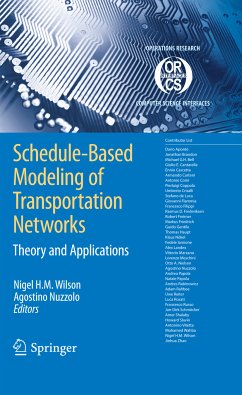
Warehousing in the Global Supply Chain (eBook, PDF)
Advanced Models, Tools and Applications for Storage Systems
Redaktion: Manzini, Riccardo
Versandkostenfrei!
Sofort per Download lieferbar
160,95 €
inkl. MwSt.
Weitere Ausgaben:

PAYBACK Punkte
80 °P sammeln!
With increased globalization and offshore sourcing, global supply chain management is becoming an important issue for many businesses as it involves a company's worldwide interests and suppliers rather than simply a local or national orientation. The storage systems significantly affect the level of quality of products, the customer's service level, and the global logistic cost. The mission of warehousing systems design, control and optimization is to effectively ship products in the right place, at the right time, and in the right quantity (i.e. in any configuration) without any damages or al...
With increased globalization and offshore sourcing, global supply chain management is becoming an important issue for many businesses as it involves a company's worldwide interests and suppliers rather than simply a local or national orientation. The storage systems significantly affect the level of quality of products, the customer's service level, and the global logistic cost. The mission of warehousing systems design, control and optimization is to effectively ship products in the right place, at the right time, and in the right quantity (i.e. in any configuration) without any damages or alterations, and minimizing costs.
Warehousing in the Global Supply Chain presents and discusses a set of models, tools and real applications, including a few case studies rarely presented with a sufficient detail by other literature, to illustrate the main challenges in warehousing activities. This includes all warehouse operations (from receiving to shipping), problems and issues (e.g. storage allocation, assignment, layout, vehicle routing) for industrial and service systems as parts of global supply chains.
Advanced and effective solving methods are also illustrated and the discussed case studies help the reader to quickly apply the proposed models and techniques/algorithms. Warehousing in the Global Supply Chain is useful to managers and practitioners of industry and service sectors for the determination and modeling of the critical issues concerning warehousing systems planning and design. It is a valuable source of information for engineering students, doctoral and post-doctoral students, and researchers of academic institutions who are searching for advanced modeling approaches and solving techniques to complex logistic decisionmaking problems.
Warehousing in the Global Supply Chain presents and discusses a set of models, tools and real applications, including a few case studies rarely presented with a sufficient detail by other literature, to illustrate the main challenges in warehousing activities. This includes all warehouse operations (from receiving to shipping), problems and issues (e.g. storage allocation, assignment, layout, vehicle routing) for industrial and service systems as parts of global supply chains.
Advanced and effective solving methods are also illustrated and the discussed case studies help the reader to quickly apply the proposed models and techniques/algorithms. Warehousing in the Global Supply Chain is useful to managers and practitioners of industry and service sectors for the determination and modeling of the critical issues concerning warehousing systems planning and design. It is a valuable source of information for engineering students, doctoral and post-doctoral students, and researchers of academic institutions who are searching for advanced modeling approaches and solving techniques to complex logistic decision making problems.
Warehousing in the Global Supply Chain presents and discusses a set of models, tools and real applications, including a few case studies rarely presented with a sufficient detail by other literature, to illustrate the main challenges in warehousing activities. This includes all warehouse operations (from receiving to shipping), problems and issues (e.g. storage allocation, assignment, layout, vehicle routing) for industrial and service systems as parts of global supply chains.
Advanced and effective solving methods are also illustrated and the discussed case studies help the reader to quickly apply the proposed models and techniques/algorithms. Warehousing in the Global Supply Chain is useful to managers and practitioners of industry and service sectors for the determination and modeling of the critical issues concerning warehousing systems planning and design. It is a valuable source of information for engineering students, doctoral and post-doctoral students, and researchers of academic institutions who are searching for advanced modeling approaches and solving techniques to complex logistic decisionmaking problems.
Warehousing in the Global Supply Chain presents and discusses a set of models, tools and real applications, including a few case studies rarely presented with a sufficient detail by other literature, to illustrate the main challenges in warehousing activities. This includes all warehouse operations (from receiving to shipping), problems and issues (e.g. storage allocation, assignment, layout, vehicle routing) for industrial and service systems as parts of global supply chains.
Advanced and effective solving methods are also illustrated and the discussed case studies help the reader to quickly apply the proposed models and techniques/algorithms. Warehousing in the Global Supply Chain is useful to managers and practitioners of industry and service sectors for the determination and modeling of the critical issues concerning warehousing systems planning and design. It is a valuable source of information for engineering students, doctoral and post-doctoral students, and researchers of academic institutions who are searching for advanced modeling approaches and solving techniques to complex logistic decision making problems.
Dieser Download kann aus rechtlichen Gründen nur mit Rechnungsadresse in A, B, BG, CY, CZ, D, DK, EW, E, FIN, F, GR, HR, H, IRL, I, LT, L, LR, M, NL, PL, P, R, S, SLO, SK ausgeliefert werden.













